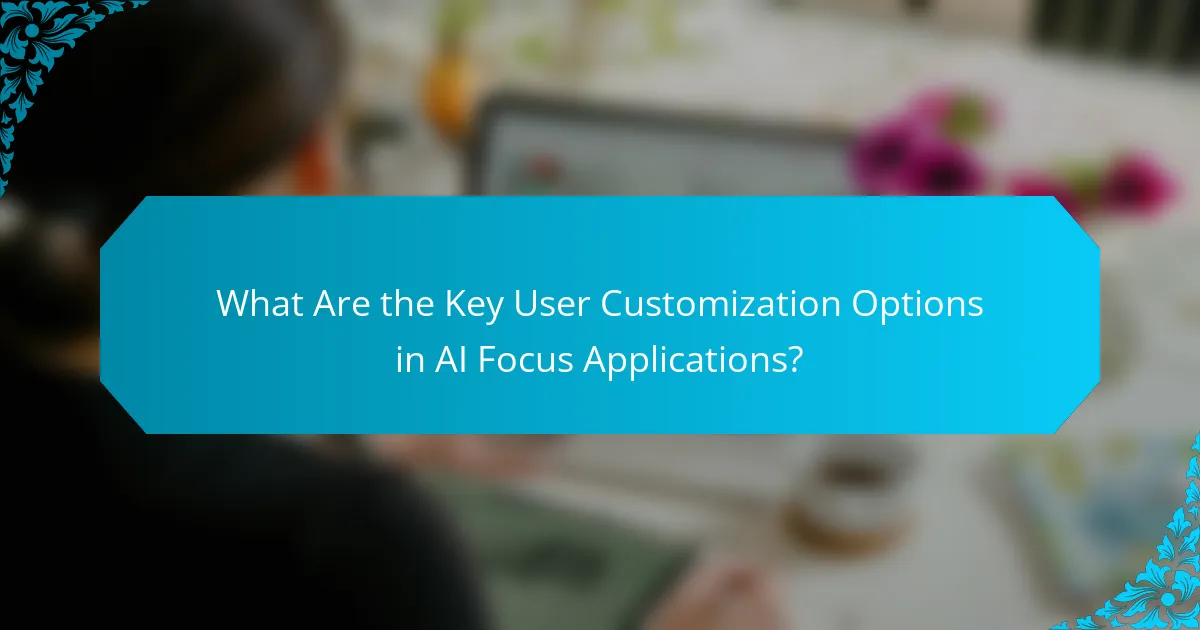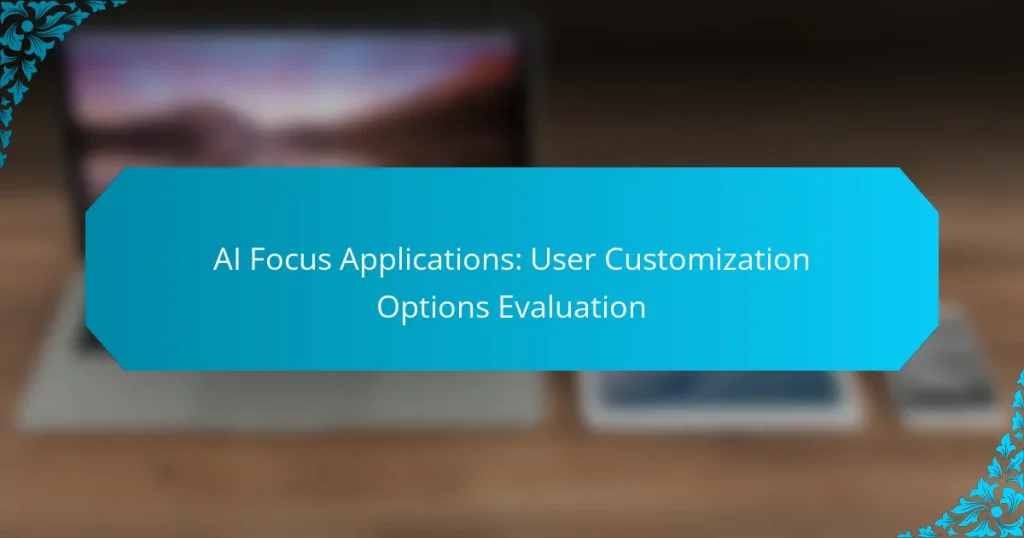User customization options in AI focus applications play a crucial role in enhancing the overall user experience by allowing individuals to personalize various aspects of the interface and functionality. By aligning features with user preferences, these options not only boost engagement but also improve satisfaction, making interactions more efficient and enjoyable.

What Are the Key User Customization Options in AI Focus Applications?
Key user customization options in AI focus applications enhance user experience by allowing individuals to tailor the interface, functionality, and privacy settings to their preferences. These options can significantly improve engagement and satisfaction by aligning the application’s features with user needs.
Personalized User Interfaces
Personalized user interfaces allow users to modify the layout, color schemes, and functionality of an application to suit their preferences. For instance, users might choose a dark mode for better visibility or rearrange widgets for easier access to frequently used features. This level of customization can lead to a more intuitive and enjoyable user experience.
When implementing personalized interfaces, consider the balance between customization options and usability. Too many choices can overwhelm users, while too few may not meet their needs. A good practice is to offer a few core customization features that are easy to access and modify.
Adaptive Learning Algorithms
Adaptive learning algorithms adjust the application’s behavior based on user interactions and preferences. For example, an AI-driven recommendation system might learn from a user’s past choices to suggest relevant content or features. This personalization can enhance user satisfaction by making the application feel more responsive and tailored to individual needs.
To effectively leverage adaptive learning, ensure that the algorithms are transparent and allow users to provide feedback. This can help refine the system and improve its accuracy over time, creating a more engaging experience.
Customizable Notification Settings
Customizable notification settings enable users to control how and when they receive alerts from the application. Users can choose to receive notifications via email, SMS, or in-app messages, and can often set preferences for the types of alerts they want to receive. This flexibility helps users stay informed without feeling overwhelmed by unnecessary updates.
Encourage users to regularly review and adjust their notification settings to align with their current needs. Providing a simple interface for managing these preferences can enhance user satisfaction and reduce notification fatigue.
User-Defined Data Privacy Controls
User-defined data privacy controls allow individuals to manage how their data is collected, stored, and shared within AI applications. Users can often set preferences for data usage, opt-in or opt-out of data sharing, and access their data for review or deletion. This level of control is crucial for building trust and ensuring compliance with regulations such as GDPR.
To enhance user confidence, clearly communicate privacy policies and provide straightforward options for managing data settings. Regularly updating users on their data rights and any changes to privacy practices can further strengthen trust.
Integration with Third-Party Tools
Integration with third-party tools allows users to connect AI applications with other software they use, enhancing functionality and streamlining workflows. For example, a project management AI might integrate with calendar applications to automatically schedule tasks and deadlines. This interoperability can significantly improve productivity and user satisfaction.
When offering integration options, prioritize compatibility with popular tools that users are likely to already use. Providing clear documentation and support for these integrations can facilitate smoother user experiences and encourage adoption.

How Do AI Focus Applications Enhance User Experience?
AI focus applications significantly enhance user experience by tailoring interactions to individual preferences and needs. Through advanced algorithms, these applications provide personalized content, streamline processes, and offer immediate feedback, making tasks more efficient and engaging.
Improved Engagement Through Personalization
Personalization in AI focus applications allows users to receive content and recommendations that align with their interests and behaviors. For instance, a music streaming service might suggest playlists based on listening history, increasing user satisfaction and retention.
To implement effective personalization, consider leveraging user data responsibly while ensuring compliance with privacy regulations, such as GDPR in Europe. Regularly update personalization algorithms to reflect changing user preferences and enhance engagement.
Streamlined Workflows with Automation
Automation in AI focus applications simplifies repetitive tasks, allowing users to focus on higher-value activities. For example, email sorting and scheduling can be automated, reducing time spent on administrative duties and increasing overall productivity.
When integrating automation, ensure that it complements existing workflows rather than complicating them. Start with simple tasks and gradually expand automation capabilities, monitoring user feedback to refine processes.
Real-Time Feedback and Adaptation
AI focus applications provide real-time feedback, enabling users to adjust their actions based on immediate insights. This feature is particularly useful in learning environments, where students can receive instant assessments on their performance.
To maximize the benefits of real-time feedback, design systems that clearly communicate suggestions and adjustments. Encourage users to engage with feedback actively, fostering a culture of continuous improvement and adaptation.

What Are the Best Practices for Evaluating Customization Options?
Evaluating customization options effectively involves understanding user needs, comparing with competitors, and leveraging user feedback. These practices help ensure that the customization features meet user expectations and enhance overall satisfaction.
Assessing User Needs and Preferences
Understanding user needs and preferences is crucial for effective customization. Conduct surveys or interviews to gather insights on what features users value most, such as interface adjustments or functionality enhancements. Aim for a diverse sample to capture varying perspectives.
Consider creating user personas that represent different segments of your audience. This approach helps in tailoring customization options that resonate with specific groups, ensuring that the features offered are relevant and useful.
Benchmarking Against Competitors
Benchmarking against competitors allows you to identify industry standards and gaps in your offerings. Analyze the customization features provided by leading competitors to understand what works well and what does not. This can include reviewing user reviews and ratings on platforms relevant to your market.
Compile a comparison table highlighting key customization features across competitors. This visual representation can help you pinpoint areas where your product may fall short or excel, guiding your development strategy effectively.
Utilizing User Feedback for Iteration
User feedback is invaluable for refining customization options. After implementing features, actively solicit feedback through various channels, such as in-app surveys or community forums. This ongoing dialogue helps you gauge user satisfaction and identify areas for improvement.
Establish a feedback loop where user suggestions are regularly reviewed and prioritized for future updates. This practice not only enhances user engagement but also fosters a sense of ownership among users, as they see their input directly influencing product evolution.

Which AI Focus Applications Offer Advanced Customization Features?
Several AI focus applications provide advanced customization options, allowing users to tailor functionalities to meet specific business needs. These applications enable organizations to enhance user experience and improve operational efficiency through personalized settings and features.
Salesforce Einstein
Salesforce Einstein offers robust customization capabilities that allow businesses to integrate AI into their customer relationship management (CRM) processes. Users can personalize dashboards, automate workflows, and create tailored predictive models based on their unique data sets.
To maximize Einstein’s potential, organizations should focus on defining clear objectives for AI implementation and ensure data quality. Common pitfalls include neglecting user training and failing to regularly update the models based on new data trends.
Microsoft Azure AI
Microsoft Azure AI provides extensive customization options, enabling users to build, train, and deploy machine learning models that fit their specific requirements. It supports a variety of programming languages and frameworks, allowing for flexibility in development.
When using Azure AI, businesses should consider the integration of existing systems and the scalability of their solutions. A practical tip is to start with small pilot projects to evaluate effectiveness before scaling up.
IBM Watson
IBM Watson is known for its advanced customization features, particularly in natural language processing and data analysis. Users can create tailored applications that leverage Watson’s capabilities to meet industry-specific needs, such as healthcare or finance.
To effectively utilize Watson, organizations should focus on defining the specific use cases and ensuring compliance with relevant regulations, especially in sensitive sectors. Regularly reviewing the performance of customized applications can help maintain their relevance and effectiveness.

What Are the Challenges in Implementing User Customization?
Implementing user customization presents several challenges, including balancing personalization with data privacy, ensuring usability, and managing technical complexities. Organizations must navigate these obstacles to create effective and user-friendly customized experiences.
Data Privacy Concerns
Data privacy is a significant challenge in user customization, as collecting personal information can lead to potential misuse or breaches. Users are increasingly aware of their data rights, making it essential for companies to prioritize transparency and security.
To address privacy concerns, organizations should adopt practices such as anonymizing user data and obtaining explicit consent before data collection. Compliance with regulations like the General Data Protection Regulation (GDPR) in Europe is crucial to avoid legal repercussions and build user trust.
Companies can also implement clear privacy policies and provide users with control over their data, including options to opt-out of data collection. This approach not only enhances user confidence but also fosters a more positive relationship between users and the platform.


